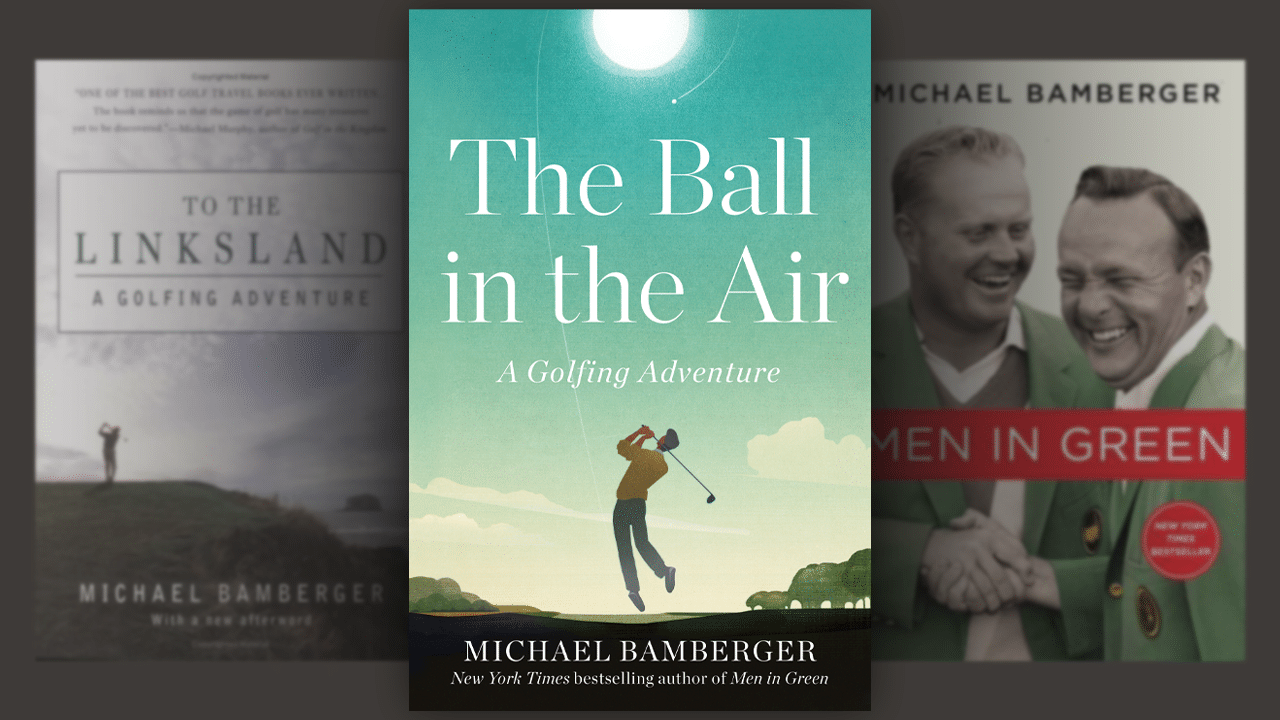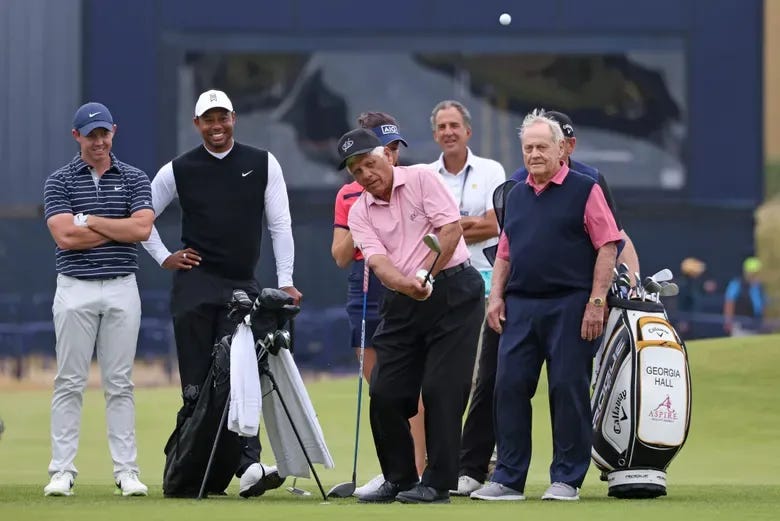The Ball in the Air
Michael Bamberger has been typing. Here are the first 1,373 words of his new book, out this week
Lee Trevino was throwing a party. He was on a driving range, putting on a show for an audience of two, a father and his son. Or three, if you count the ringmaster. With every word and swing,
Lee Trevino was amusing himself, too. He was in his 80s. He was ridiculously boyish.
It was a warm December afternoon in central Florida, with Christmas in the air. Trevino was wearing long navy shorts and a black baseball cap, tufts of perfect silver hair spilling out from the sides and back. He was performing magic tricks with golf clubs.
The father, Tiger Woods, half Trevino’s age, was entranced. By his example, he was inviting his son, closing in on 13, to watch this funny little magician in action.
Sunset was coming. Not that Trevino cared.
“Charlie,” the old man said, trying to get the boy’s attention.
Hee-hee-haw-haw-hee-hee.
Trevino was laughing at his good fortune—Tiger Woods was paying attention to him. He clapped his hands, to punctuate his delight.
Trevino then played a slicing, spinning pitch shot, not with a wedge, as you might expect, but with a driver. He was practicing his art, showing off his dance moves, inventing swings, offering commentary all the while. His shots were coming out of his mouth, his eyes, his stout legs and round body, his meaty hands and nimble brain, the left side of it and the right side, too.
Tiger had already buried his father, said farewell to Arnold, stopped writing his own chasing-Jack story, too battered, in every way, to soldier on. He was a man in transition. To what, he couldn’t know. His son was just starting out. And before them was this old puppet master. Trevino was deep into his back nine, but Tiger knew what all golfers knew, that Lee Trevino would go to his maker playing golf shots.
Three generations, right there, on that range. One starting (a first act), one turning (a second), one finishing (a third).
Golf runs in threes. Balls, new ones, come in sleeves of three. When you review your round in the trapped heat of a parked car, you count and rue your three-putt greens, don’t you? All the while, you can’t wait for another crack at it. Our game.
Tiger would have been an icon of golf even if he had quit playing in college. Charlie had started to play some junior events. But Trevino never played amateur golf at all.
He came to golf by way of a maintenance shed at a Texas golf course and was done with school by the 10th grade. Golf became his teacher. His desire to understand the game proved to be insatiable so he stayed at it, a perpetual student. A lifer. Yes, the need for money drew him to the course. But then the game cast her spell on him. As she does.
“The greatest ball-striker there is, right here,” Trevino said, motioning toward Tiger with the back of his bare right hand. He was stepping into a shot.
“Oh, come on,” Tiger said.
“You had power!” Trevino said.
Tiger knew better. Power comes and power goes. He learned that the hard way.
“You’re the best I’ve ever seen,” Tiger said, not loudly.
Trevino kept hitting shots, one rhythmic swing after another, the ball coming off the sweet spot of his club with something that sounded like joy.
I picked up a golf club for the first time in Mr. Greenlee’s eighth-grade gym class at a public middle school where my mother later taught English, near the train station in the village of Patchogue, on the south shore of Long Island. We were in the gym, hitting plastic balls off plastic mats with real clubs, aiming for backboards.
A couple months later, the U.S. Open was played at Winged Foot, 65 miles and several lightyears from my home. Our morning paper/bible, The New York Times, devoted many column inches to it, with nods to Arnold Palmer, to Jack Nicklaus, to Lee Trevino. He was the Merry Mex that week, in the paper’s smudgy black ink.
Eleven years later, I was caddying in the PGA Championship at Cherry Hills Country Club, near Denver. My player, the head pro from a club in Winged Foot’s long shadow, made the cut and finished early. Later that Sunday I watched Hubert Green and Lee Trevino duke it out for the title.
That night, I was driving with Al Geiberger and his wife and their young son to Al’s next event, the Jerry Ford Invitational. The son said something about Hubie Green. Al said, “I think Mike was rooting for Lee.” I don’t know why he said it. I remember it because it was insightful and unexpected, and because I was in the thick of Act I. We all remember what that’s like.
Fifteen years after that, Lee Trevino used a club I designed in the British Open, his final one, at the Old Course. He wasn’t playing to cash a check. His goal, at age 60, was to shoot the lowest score he could, and that’s why my little invention was in his bag, one of his 14 clubs. (The E-Club, U.S. patent number 6,033,320.) He used it, and he bragged to reporters and others about its properties. If that’s not the highlight of my second act in golf, I don’t know what is.
Trevino was then at the start of his third. Zero to 30, 30 to 60, 60 to 90, if you start young and go deep. Trevino missed the cut, not that it mattered. Tiger won.
And then somebody flipped a switch, another 21 years passed and there was Trevino, in his early 80s but otherwise little changed, standing on that driving range in central Florida, Tiger and Charlie Woods beside him. This was at the Father-Son tournament. The broadcaster Roger Maltbie was on the scene. The Course Whisperer.
I asked him, “Does anybody know more about the golf swing than Lee Trevino?”
Rog thought for a half-moment and said, “Nobody knows more about his own swing than Trevino knows about his.”
Charlie’s swing was pure youth. Long, fast through the ball, flowing. He was Gumby, as Tiger once had been. Tiger’s swing was a grunt. Trevino’s was the art of invention. He had moved beyond the professional ranks and tournament ambition. He seemed half-drunk (no, not literally), standing and swinging on that range, lifted by the satisfaction that comes with being relevant and alive. Later was later. Later he came down. He was done with golf for the day and he had turned surly and rough.
But for a while there he had it in his hands, and the next day, maybe, he would have it again.
This golf. The game for a lifetime, old people said when I was a kid and here I am, repeating their words. I’m not apologizing for the role it plays in my life anymore. Golf taught me to be punctual, among other things. To be courteous, to be aware, to try. Golf is hard. I cite that as a positive.
The people I have met along the way—it almost doesn’t seem fair. Here are three. Pratima Sherpa, from Nepal, age 23 (eventually in these pages) and playing college golf in Los Angeles. My fellow reporter Ryan French, from Alpena, Michigan, recovering fast-food restaurant manager who found a place in the game in his 40s by writing about golf’s dreamers, unearthing some miscreants while he was at it. And my friend Sam Reeves, pushing 90, with a home in Pebble Beach but really at-large in the world, wise beyond his years and still both at it and in it. I thought he might have a damn heart attack one morning as we stood on a driving range and he made these alarmingly aggressive warm-up swings with a headless shaft.
Here at the start, let me say this about Pratima and Ryan and Sam, and I could easily bring in Trevino and make it a foursome. They all know what it’s like, to marvel at a white ball in a high sky and get lost. What a gift that is.
You know what I’m talking about, right?
The Ball in the Order may be ordered here.
Michael Bamberger welcomes your comments at Bamberger@firepitcollective.com




